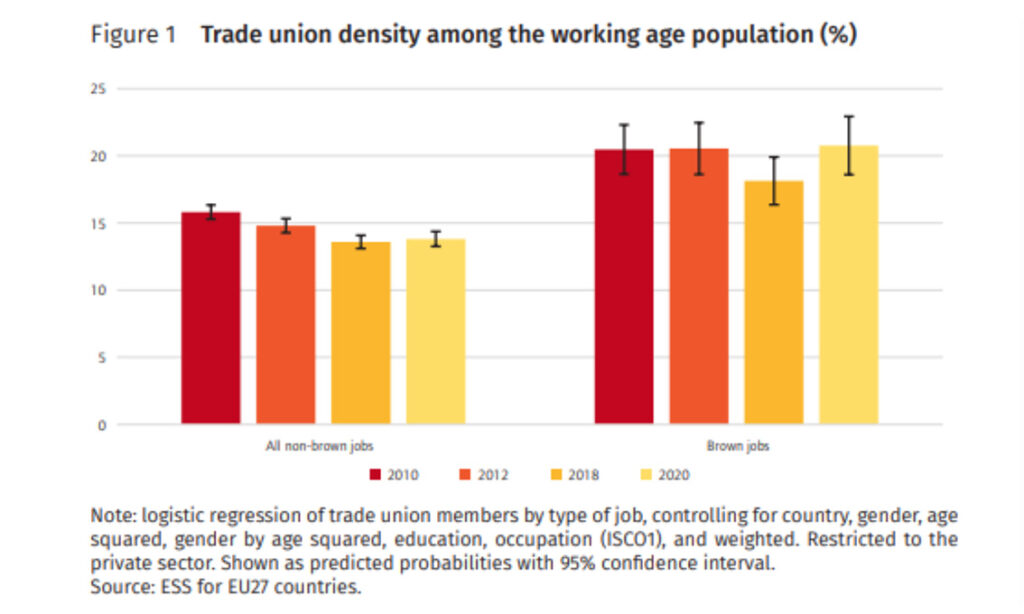Introduction
The green transition is one of the key transformations facing the world of work and among the top priorities for the European Commission and the social partners. A substantial part entails shifting economic activity from more polluting to less polluting industrial activities through a variety of climate policy instruments including taxes and incentives. The Green Deal Industrial Plan (GDIP) mentions that new jobs must be quality jobs, but does not detail what aspects of quality are meant. This technical brief highlights one crucial aspect of job quality; namely, the representation of workers and workers’ voice (Piasna 2023). Worker representation is a prerequisite for better quality jobs and a cornerstone of democracy at work. It is also an important aspect of yet another aim of the European Union through the Minimum Wage Directive (Müller and Schulten 2020); that is, the coverage of 80% of workers by collective bargaining, necessitating the presence and involvement of strong social partners. Representative data are deployed from a range of sources to test the differences between jobs that are expected to be more deeply affected by the green transition, as they are more polluting than the others, in terms of union density, worker representation and collective agreement coverage. The findings show that jobs in more polluting sectors are generally characterised by having relatively good conditions in this sense as they have an above-average likelihood of being covered by a collective agreement as well as above-average union density and access to worker representation.
Changes in employment
The green transition implies a decline in those sectors characterised by polluting economic activities, featuring so-called ‘brown jobs’ (European Commission 2019; Vandeplas et al. 2022); and a growth or change in jobs that contribute to the green and renewable economy (Vona 2021; IMF 2022). While somewhat speculative, most estimates put the amount of truly polluting brown jobs in Europe at around 5% (Vona 2021; Vandeplas et al. 2022). Of course, these jobs are heterogenous and these activities will persist in the green transition, but they are also likely to undergo substantial changes during the shift. Earlier research has shown that jobs in the brown economy are generally more likely to be carried out by men, and commonly by older, lower qualified and more often low-skilled labour (Vandeplas et al. 2022). This is important as these are profiles that will have more trouble finding new jobs in the emerging sectors or in the economy as a whole.
Following the literature, this brief classifies brown jobs as those in pollution intensive industries (Vandeplas et al. 2022).1 This is, by necessity, a limited approach as it groups together large sets of industries with very diverse conditions. It should be interpreted as that group of jobs that are, on average, found in more polluting sectors and those most at risk of being affected by the transition. Indeed, the total number of workers in these sectors across the EU27 dropped from 1.8 million to 1.4 million between 2008 and 2022, corresponding to a fall from around 9.4% of the workforce to 7.1% (Eurostat 2023). This is not uniformly the case though, as there is substantial variation between sectors.
Measuring worker representation
This brief focuses specifically on the representation of workers through trade unions and through collective agreements, both of which are important aspects of job quality (Piasna 2023). Collective agreements are associated with higher wages and lower wage inequality overall (Zwysen 2023; Zwysen and Drahokoupil 2023). Important as well is the new EU Minimum Wage Directive which sets forth a goal of 80% of workers being covered by collective bargaining, a level that most Member States do not reach at the moment. In that vein, it is important to be aware of the difference between jobs that are found in polluting areas, and which are set to diminish and transform over time, and the average.
In comparing worker representation between sectors, the analysis is restricted to the private market sector – that is, it excludes the public sector, education, health, the creative industries and social services.
The key question is how jobs in the more polluting industries compare to other jobs in terms of worker representation. Rather than compare only to ‘green jobs’, these are compared to all remaining jobs as the vast majority of the latter do not themselves contribute to the transition but are ones in which there will still be a transformation.
As there are various aspects to worker representation, several recent data sources are used to characterise these jobs and shed light on this important aspect of job quality and the green transition. Importantly, not all jobs in brown sectors should be seen as quality jobs.
Trade union density remains stable in brown jobs but is declining elsewhere
First, using the European Social Survey it is possible to study the trends in union density in brown jobs and all the rest in the private sector right across the EU27. As workers in brown jobs also differ from other workers in terms of their characteristics – age, gender, type of work and education – which, in turn, affect unionisation, these are accounted for through a regression model controlling for gender by age and age squared, highest obtained qualification and occupation. All analyses are weighted and representative of workers aged 16-64 in the private market sector.
Figure 1 shows the share of workers that are members of a trade union depending on whether they work in brown jobs or in any other job. This shows that, in 2010, 15.8% of workers in non-brown sectors were members of trade unions compared to 20.5% of those working in brown jobs. By 2020, trade union density among workers in non-brown jobs had declined by about two percentage points, while that among those working in brown jobs had remained stable at 21%, as shown in Figure 1, although there was a small dip in 2018.
This pattern shows that (1) brown jobs have a significantly higher rate of unionisation, at five percentage points in 2010 and seven in 2020, compared to other private sector jobs; and (2) that union density does not seem to be declining in these jobs.

Collective bargaining coverage by type of job
Second, the role of social dialogue can be captured by collective bargaining coverage by countries and sectors. This differs from union density as it portrays the extent to which workers are covered by collective agreements which determine their pay.
Industry classification in the Structure of Earnings Survey (SES) is at a somewhat higher level of aggregation, meaning some sectors are combined. Figure 2 below shows that, keeping characteristics such as gender, age, education, establishment size and occupation constant, in most countries in the EU the coverage rate by collective agreements on pay is substantially higher among workers in brown jobs than among the rest.
On average, these workers are about 2.5 percentage points more likely to be covered by a collective pay agreement. This covers a substantial amount of heterogeneity however, with differences of over 10 percentage points in Bulgaria, Czechia, Cyprus, Estonia, Hungary and Malta. As an exception, collective pay agreements are somewhat less common in brown jobs than non-brown ones in Finland, Germany, Greece and Portugal; while there is no substantial difference in Belgium or France.
A decline in these brown jobs, without an increase in collective bargaining coverage elsewhere, would thus result, on average, in a decline of collective bargaining overall. Problematically, this would be especially the case in some central and eastern European countries that have generally lower collective bargaining coverage to begin with (Zwysen and Drahokoupil 2023).

Greening by occupations – trade unions in the workplace
Thirdly, worker representation can also be taken more widely. This is explored using the European Working Conditions Survey, carried out as a telephone interview in 2021 (EWCTS). In this wave, the EWCTS classifies workers into four groups based on their occupation-based tasks: a) those where no impact of the green transition is expected; b) those where the green transition would result in increased demand for these services or goods; c) those where the jobs would continue but require new skills and training; and finally d) those occupations in which new and emerging jobs are expected to appear. This is therefore a different measure of the proportion of workers likely to be affected by the green transition, based on occupation. This data is used to make two comparisons: a sector-based comparison of workers in brown jobs to those in non-brown ones; and an occupation-based job comparison of those jobs expecting some impact from the transition to those where no impact is expected.

Figure 3 shows, in the left panel, how the estimated probability of having a trade union, other system of worker representation or a works council in the workplace differs between workers in brown sectors and others; and then, in the right panel, compares the different occupational classifications where some change is expected as a result of the green transition to all workers in occupations that expect no impact from it – that is, those which do not expect greater demand, new skills or completely new jobs.
The left panel uses the same comparison as the rest of this brief – brown sectors rather than all others in the private sector. Here as well, workers in brown jobs are, on average, 13 percentage points more likely than the rest (64% vs 51%) to have access to a worker representative.
The right panel highlights that jobs where specifically new skills will be required do not really differ from occupations that are not expected to be affected, with the differences not being statistically significant. However, workers in occupations where new types of jobs are expected are close to five percentage points more likely to have some workplace representation than those in jobs where no change is expected; while, for workers in occupations where greater demand for labour is expected, this difference is even greater, at 10 percentage points. This indicates that the occupations likely to be affected most by the green transition are also those where workers are, on average, relatively well represented.
Conclusion
When considering the issue of job quality and the green agenda, it is important not to overlook that those jobs that are in the most polluting industries also tend to have high worker representation, as well as stronger involvement in social dialogue as measured by the conclusion of collective agreements. These sectors are generally already declining over time in terms of employment share, and the transition is likely to lead to further changes in the structure of employment. While these changes are necessary for the green transition, we should not lose sight that this poses, on average, greater risk to those jobs where workers are well covered and generally well protected, and that the risks of an extension of precarity and insecurity have to be averted.
The EU’s Green Deal Industrial Plan makes it very clear that the new jobs created should, in principle, be quality jobs. It is also important, however, not to forget this particular dimension of job quality – the representation of workers. When considering the green transition, more weight must be given to ensuring that the new jobs – and the economy as a whole – offers enough opportunities for workers for good and fruitful labour. Moreover, this is also likely to increase public support for the green transition, as it should not be seen as, or result in, a loss for workers. It is crucial therefore that workers in new and emerging industries are sufficiently represented, while particular care needs to be taken that the new jobs provide similar collective bargaining and protection. Otherwise, it will be even more difficult to reach the 80% collective bargaining coverage rate set out in the Minimum Wage Directive.
___________________________________________________________________
1. These are: A03 fishing and aquaculture; A01 crop and animal production; B mining and quarrying; C20 manufacture of chemicals and chemical products; C24 manufacture of basic metals; E37-E39 sewage, waste collection and treatment, and remediation activities; C23 manufacture of other non-metallic mineral products; H51 air transport; H50 water transport; D electricity, gas, steam and air conditioning supply; and C19 manufacture of coke and refined petroleum products.
Link to the original publication, where you can find the pdf file and the references: https://www.etui.org/publications/green-transition-and-job-quality-risks-worker-representation
-
 Wouter Zwysen
Wouter Zwysen
Wouter Zwysen has degrees in political science and social policy analysis from the University of Antwerp and the Catholic University of Leuven. He gained a doctorate at the Institute for Social and Economic Research, University of Essex, in Applied Social and Economic Research. He worked as a post-doctoral researcher on a European research project “Growth, Equal Opportunities, Migration and the Markets”. He then worked at the OECD in the Employment, Labour and Social Affairs directorate, carrying out research on wage inequality and firm productivity. He is a senior researcher in ETUI (European Trade Union Institute).




